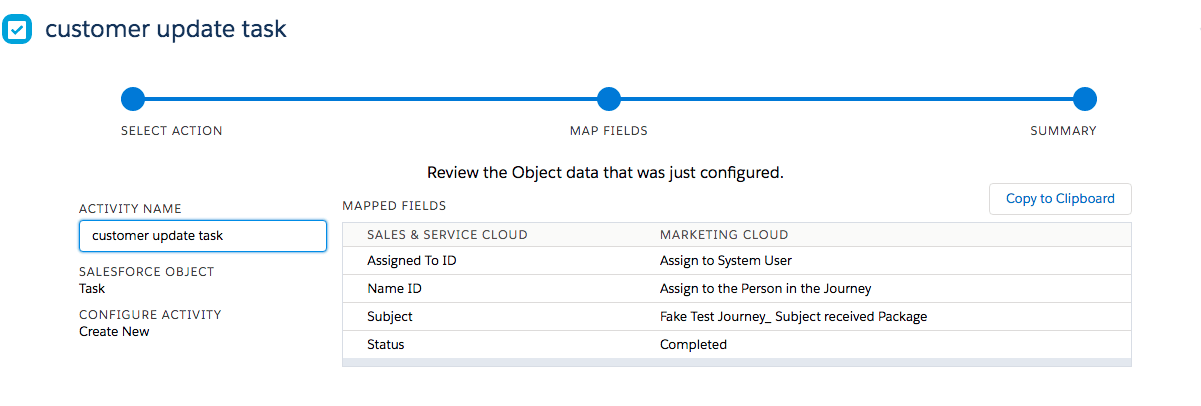Download our Ebook
Understanding the team structure, challenges, solutions and protips from CRM Experts
Kerry
Townsend
London Marketing Cloud User Group Leader
Principle Consultant at AmberStar Consulting
As the complexity of your journeys increases, divide it into sections or modules, making them easier to test and update...

Kerry
Townsend
London Marketing Cloud User Group Leader
Principle Consultant at AmberStar Consulting
Best practices for those who are starting on their journey with Journey Builder...
Journey Builder is a very powerful tool for automating the sending of messages in Marketing Cloud. The capability is increasing with almost every release. It is very easy to get started with simple journeys with the drag and drop interface. However, don't let this trick you into thinking that you don't need to approach medium to complex journeys with good planning.
- As the length and complexity of your journeys increase, you might want to divide the journey into sections or modules making them easier to test and update. Modular journeys are easier to see on the canvas and for others to understand, without being overwhelmed. It also means modules can be reused. This is a common design practice with automation tools including code. If you need specific Goal behaviour, this might not be the right approach but it is worth asking the question 'Should we break this into modules?'
- Another important planning consideration is making sure that you know how you want to measure the success/ performance of the journey. You may get all the information you need from the standard reports or the functionality that lets you see where a person is in the journey. But in addition, you might want to do some more detailed analysis on how people progress through the journey. Some analysis is only possible if attributes are captured in a Data Extension as a person progresses through different paths. It is important to be clear on these requirements during the design of the journey. Nobody wants to be asked for a performance metric by an executive that you haven't got the data for a month into a Journey being live.
- And finally test, test, test.
Mateusz
Dąbrowski
Salesforce Marketing Champion
Marketing Cloud Architect at PwC
Focus on the purpose, remove everything that does not provide value and strive for an exquisite customer experience...

Mateusz
Dąbrowski
Salesforce Marketing Champion
Marketing Cloud Architect at PwC
- Configuring Journeys is a treat, but it should come after dinner. And by that, I mean starting with asking yourself:
- What is the purpose of the Journey?
- Why should customers care?
- Where and when will they be able to act on it?
If there is more than one "what", you should split the Journey.
If there is no "why", you shouldn't make this Journey.
If you don't know "where" & "when", you won't be able to configure the send times and channels (Einstein STO can help with the latter).
- Simple is better than complex. Complex is better than complicated.
Those rules from Zen of Python are the perfect guide for Journey creation. With the multitude of options and flexibility offered by Marketing Cloud, you can do nearly everything in the Journey. But that doesn't mean you should.
Focus on the purpose, remove everything that does not provide value and strive for an exquisite customer experience.
- Test. Always and everywhere. But with purpose. Testing for the sake of testing won't lead anywhere.
- Look at the current data.
- Select a metric you want to improve.
- Create a hypothesis.
- Test it against meaningful segment size.
- Analyse the results.
- Repeat.
Minor continuous improvements lead to tremendous results.
Karin
Holmgren
Salesforce Marketing Champion
Ecommerce Sales Operations at Pitney Bowes
If using an automated process for dropping people into the journey, build safety nets and data checking around the entry point...

Karin
Holmgren
Salesforce Marketing Champion
Ecommerce Sales Operations at Pitney Bowes
- Planning - Old fashioned but it works.
Map the journey on a digital whiteboard (or the old-fashioned way, with pen & post-it) with your stakeholders.
Create a row for what the customer sees or does, what tool does the work (a CRM, an FTP, other analytics tools), and what those tools do – record activity (like click rate), send an order to another system, send a text. This gives the full breadth of what the "simple" journey is doing to your stakeholders and teammates.
- Content is not a silver bullet
There’s no guarantee that an infographic or whitepaper will seal the deal. These types of content surely influence the deal; perhaps they also speed the velocity to close the deal or increase the value of the deal by cross-selling or upselling. In a journey, look for engagement and these two metrics to see which piece of content is working – and then switch it up to see if you get different results.
- The data trigger
The single-most important element of your data is the data trigger. What information will trigger your system to start the journey? What data fields point to a customer action? It is often a date field. This could be an order completion date (or not, in the case of an abandoned cart date), a contract signing date or date of product being turned on for the first time. Where is that data and how can you connect it to your email program? Be wary if the date field could be overwritten by a repeat behavior. You’ll have to build in safeguards for the action to be triggered once (or restrict re-entry).
- Safety nets create security
If using an automated process for dropping people into the journey – build some safety nets and data checking around the entry point. Should a competitor be entered? Will you require a business email address that might match exactly to your CRM? When creating audiences for journeys, especially for prospects, think of how the systems should handle existing leads – should a new lead be created? If an existing lead was converted and is now connected to an open deal, should the potential client enter a new prospect journey? If a repeat client enters your journey, how will Sales handle it?
- Take a journey globally…Faites un voyage dans le monde
Many believe an English-language journey can be easily pushed to other countries, simply translating the language. I recommend having a native-speaker review the content as a tester, as well as your customer service. Content links should lead to in-language websites and content, including collection forms (and auto-responders). Footer links need to be redirected to in-country customer service. Even the timing of the email delivery should match a proper time zone and business hours for that country. Be careful of sending emails on the weekend or outside of business hours. With changing data privacy laws, the set up and processing of the list, footer language and actions may be different for each country.
- Success is in the numbers
When designing the journey, which metrics really matter? Is it engagement (opens, clicks) in a lead warming scheme? That’s easy. Is it converting prospects to contacts, then deals? You can report on the lead conversion and include the deal value. Look beyond the actions of the journey to find meaningful measurements. Are you testing subject lines, call to actions or other content? Tip: If the goal of the journey is to create quality leads for sales, be sure the list isn’t already scored as qualified in your CRM.
Shweta
Dawar
Salesforce Marketing Champion
Salesforce Marketing Cloud Consultant at Accenture
Remember that you cannot edit decision splits once the journey is live; test your journeys before you push them live...

Shweta
Dawar
Salesforce Marketing Champion
Salesforce Marketing Cloud Consultant at Accenture
- Before I get started with mapping out my journey in the journey builder, I first create a journey map using a tool like lucidchart. This not only helps with clearly visualizing the journey and the various decision splits, but it also helps mitigate any errors.
- In addition to the journey map, I also make sure to add in all the data points at every step of the map in lucidchart so I can keep track of every possible information that is needed or to be built at every step of the journey. This means I know exactly what's going to go in the different steps of the journey even before I start building it in the journey builder.
- Once the journey map is ready, I open the journey builder and build out the journey. If I know that I might need to build out a similar journey in the future, I make sure to save the journey as a template. When creating journeys, it is important to remember that you cannot edit decision splits once the journey is live, so take extra care in testing your journeys before you push them live. For testing journeys, you can lower the wait time to 1 minute ( instead of days or hours) so that you are able to test the journeys end-to-end.
Alex
Mackey
Salesforce Marketing Champion
Senior Consultant at Coastal Cloud
Bring all data in the entry event data vs trying to do everything through AMPScript; it can hurt processing performance...

Alex
Mackey
Salesforce Marketing Champion
Senior Consultant at Coastal Cloud
- Journey planning
It sounds simple but always make sure that you have not only data, but data that you can trust, to drive entry into Journeys. Using a field(s) that might change a lot in an hour’s span might not be best for making automation decisions.
I always recommend that you take a look at those who are clicking links in your emails and (if opted in) sending them SMS messages. A good channel mix is always recommended.
- Data integration
Whenever possible I always recommend OOB solutions like FTP file drops for 3rd party data integration before moving on to solutions that require custom code like API.
- Data modeling
Always set up a lead conversion clean up process to ensure you're not holding on to two records for one person.
- Journey Builder deployment
For a long time Marketing Cloud folks were attached to the process of building a version on a Journey (likely with shortened wait times) in a Sandbox BU for testing and POC and then when once tested and approved they would rebuild in production. But fret no longer, it appears that the new Package Manager is going to change things!
- Journey performance improvement
Don't inject more than 2 million records into a Journey an hour
Bring as much data as you can with you in the entry event data vs trying to do everything through AMPScript as that can hurt processing performance
Milton Muthuraj
Thangapandi
Salesforce Marketing Champion
Senior Marketing Cloud Solution Architect at RightKey Solutions
Have a couple of master data extensions for opt-ins; link them in the contact builder by your contact key...

Milton Muthuraj
Thangapandi
Salesforce Marketing Champion
Senior Marketing Cloud Solution Architect at RightKey Solutions
- Journey Planning
Entry Source: Segment your data before the entry source of the Journey. Usually, we do not filter out the email opt-ins, mobile opt-ins, and push device opt-in and custom attribute opt-ins. We check these criteria after the entry source or inside the journey. So pre-filter and inject only the eligible contacts. This will also help you to measure your campaign effectively across channels.
Goal: Though ‘Goal’ setting is optional, I would strongly suggest using this feature to measure the performance. Marketers usually check the measures from the dashboard, or data views. If you set appropriate goals, you can achieve your marketing objectives at the Journey Goal section.
Capture Journey History: Capture important data inside the journey by using Update Contact activity especially when you use different channels, various decision splits and activities which helps you to analyze, troubleshoot and sometimes measure your journey.
- Data integration
If you have nurturing campaigns for more than 3 products, each follows different flows and gets invoked by the external system with millions of data, break the single journey into 3+ journeys. This will help you efficiently manage the campaigns, maintain the journey in future, and measure the performance easily.
- Data modeling
Have a couple of master data extensions for opt-ins for all your channels, common brand attributes, and link them in the contact builder by your contact key to properly utilize the real time data in decision split in most of your journeys.
- Journey performance
If you refer to many dynamic attributes from different data extensions in the emails in journey, it will affect the performance. So try to use as many journey data attributes as possible in the entry source which can be used in your dynamic emails.
Kim Cornwall
Malseed
Salesforce Marketing Champion
Automation Program Manager, Customer Success at GEOTAB
Instead of creating one journey for all geographic regions or countries, create separate journeys for each to achieve better results....

Kim Cornwall
Malseed
Salesforce Marketing Champion
Automation Program Manager, Customer Success at GEOTAB
Best Practices for Building Global Journeys Across Geographic Regions and Languages
If your organization does business with people in countries other than your own, it’s important to personalize their experience in order to engage your entire audience, build trusted relationships, and achieve your journey goals.
Instead of creating one journey for all geographic regions or countries, create separate journeys for each. Benefits include:
- Optimizing processing time and efficiency for entering audiences into journeys, for the journeys themselves, and syncing journey activities with other Salesforce solutions and third party applications.
- Detailed reporting on each audience and ability to compare results of each region/country journey to continuously optimize each over time. What works well in one country may not work well in another.
- Achieve better results by localizing all messaging and content for each audience’s language and cultural preferences, and using send time optimization to send emails and SMS messages at the best time for them in their timezone.
Create a global journeys plan in a shared spreadsheet (if collaborating with colleagues) with separate tabs for each geographic region or specific country journey. All journey details, and all content assets for each region or country should go into the plan and be approved prior to building the journeys.
Manish
Thaduri
Salesforce MVP
Salesforce Solution Architect at CPRV
Validate and Test are an important set of testing features in Journey builder. Do not forget to use them...

Manish
Thaduri
Salesforce MVP
Salesforce Solution Architect at CPRV
Journey builder in the Salesforce Marketing Cloud has some interesting standard configuration options that you must not ignore. Follow these best practices to get the most out of Journey Builder.
- Configure the Goal: Every journey you design has an objective and a goal. It is important to track the goal within the journey builder too. In Journey Builder, a goal is a measurement of customer actions that you want to promote. You can set a target for the total number of people or as a percentage of people reaching the marketing objective. After you configure your goal, you get a quick view of the Goal target statistics that indicate how each journey performs. It is a crucial statistic that you wouldn't want to miss tracking using the standard feature.
- Validate the journey: Validate and Test are an important set of testing features in Journey builder. Do not forget to use them. Validate lets you quickly identify the broken links and the mistakes that miss your eye. Validation confirms that the journey’s components are configured correctly and work as planned.
- Test your Journey: The 'Test' Journey is my favorite because by configuring a test journey with real contacts, the simulation shows you the exact path the contact follows in the journey based on the customer persona. With this, you'll already know if the contact will receive the expected communication before launching the journey. And all this without sending messages to the contacts you chose and ignoring the wait times in the journey, making it faster to test too.
Ashley
Anger
Salesforce Marketing Champion
Project Manager, Marketing Solutions at Coastal Cloud
Project how your data will scale in the future. If using Marketing Cloud Connect, use Lead or Contact ID as contact key...

Ashley
Anger
Salesforce Marketing Champion
Project Manager, Marketing Solutions at Coastal Cloud
- Journey Planning
Develop personas, determine clear segmentation, map out the process in a working session. By understanding the content and personalization needs, goals, and process, it will make for a more effective Journey.
- Data Integration
Have CRM be the database of record and specify the data to push to the Marketing Cloud. Sync the data that’s needed for personalization or segmentation, but you do not need it all.
- Data Modeling
Project how your data will scale in the future, especially with Enterprise-level clients. If using Marketing Cloud Connect, use the Lead or Contact ID as the contact key so it will be consistent across clouds.
- Journey Builder Deployment
Control the data coming in by adding a filter to only let people with an email address that contains [@youremaildomain] during testing, then add the client’s email domain. Once it has been approved, create a new version, remove filter, hit Save > Validate > Activate and you’re ready to launch.
- Journey Performance Improvement
Build your supporting data extensions specific to the decision you’re trying to make in the Journey, so you aren’t making your decision splits overly complicated to manage.
Jyothsna
Bitra
Salesforce Marketing Champion
Marketing Cloud Consultant/Architect at ARXCIENT
Use wait activities only when required; avoid them at the beginning of the journey or just to display contact count...

Jyothsna
Bitra
Salesforce Marketing Champion
Marketing Cloud Consultant/Architect at ARXCIENT
- Before creating the journey, have a journey strategy, map out the journey’s purpose, objective and the goal. Set only one objective per journey and do not mix more objectives into one journey.
- Although wait activities seem to be simple there are many considerations that need to be kept in mind when using wait activities. Wait activities can be used in journeys to hold a contact based on different attributes/events. While the contacts wait for their next step, they will be stored in the database and that can cause additional processing overhead for the journey.
- Use wait activities only when they are really required and do not include them at the very beginning of the journey or just to display the contact count. Avoid using wait activities that are less than 5 minutes long.
- The extent of AMPScript used in the emails/messages impacts the performance of the journey.
- Try to prepare and segment the data before they enter the journey instead of using filter criteria within the journey. The complexity of the filter criteria used in the decision splits and in the entry source also impacts the journey processing speed.
- When setting up filters, use journey data rather than contact data and make sure all the attributes used are present in the entry event data. When possible, use exact matches(=) rather than ‘ends with’, ‘contains’, etc. This avoids over usage of computing resources.
- Include the Decision Split path with highest frequency first.
- Though the journey allows usage of Domain exclusion and exclusion scripts, this may slow down the processing depending on the #contacts in the journey. Try to filter out the contacts that are not required prior to their entry using automations
Najee
Bartley
Salesforce Marketing Champion
CTO at BBVisions Multimedia
If you have a print product activity set up, always add a task to check if the activity was completed...

Najee
Bartley
Salesforce Marketing Champion
CTO at BBVisions Multimedia
One great tip that I have for Journey Builder is if you have a print product activity (postcards or packets) set up in your journey, always always add a task to check if the print product activity was completed. This will save your life when you want to check if a customer actually received their print products. Here is an example!
A student has just been accepted into the college of their dreams. Deposit is made and they are ready to go! The University wants to send them a congratulations postcard and packet of cool swag. In Journey Builder, the marketer sets up the Data extension, adds the print product activity, a wait step and a customer update task activity (see below for images). If anyone says they didn't receive a packet, the marketer can just check to see if they completed that step in the process. I cannot tell you how many times we have come across issues with a print product and this activity has saved my life. The customer update activity can be extremely helpful.
I would suggest using the update customer activity anytime you need to check a record status after a wait completes!



 +1 213 674 6665
+1 213 674 6665 contact@uplers.com
contact@uplers.com

